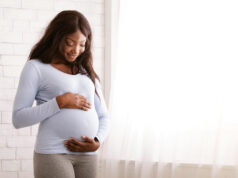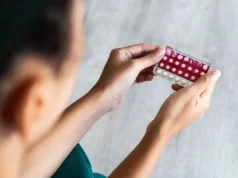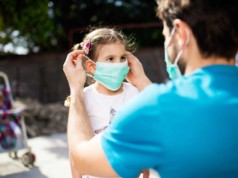Haemorrhoids are swollen veins inside the rectum or in the skin around your anus. They’re typically induced by increased pressure on your lower rectum.
When you’re pregnant, the baby is placing extra pressure on this area. As a result, postpartum haemorrhoids may develop after pregnancy.
Many women develop postpartum haemorrhoids after having a baby-especially after a vaginal delivery. Symptoms include pain, rectal itching, bleeding after a bowel movement, or swollen area around the anus.
Postpartum Haemorrhoids can cause a number of symptoms, including:
- During bowel movements, bleeding.
- Swelling
- Itching
In pregnant or postpartum moms, Postpartum haemorrhoids are often caused by perineum tension in the months before and after childbirth. The veins act like valves to force blood back to the heart, and when the valves are compromised, they can swell with blood.
You can imagine how the stress of carrying a baby and then pushing a baby out during the vaginal delivery will cause the veins to pop out. In addition, all the hormones that go through your body during pregnancy and childbirth influence how these veins function. Pregnant mothers also increased the development of the progesterone hormone, which also allows the veins to relax.
New mothers are also susceptible to constipation after birth for many reasons. This can begin a vicious cycle of needing to apply pressure to pass the bowel, feel the subsequent flare-up of the Postpartum haemorrhoids, fear of having to go again, and hold the faeces, which then hardens, beginning the process all over again.
Usually, Postpartum haemorrhoids will go away on their own. Depending on their size, position and seriousness, it can take anything from a few days to a few weeks.
Occasionally, haemorrhoids can form a painful blood clot. This is known as a thrombosed haemorrhoid. Although these clots are not fatal, they can be extremely painful. The doctor can treat this form of the haemorrhoid with a minimally invasive in-office procedure.
In addition, some haemorrhoids become chronic, lasting many months or longer. Like thrombosed haemorrhoids, they can typically be managed by a doctor.
Most cases of Postpartum haemorrhoids cure themselves, but there are a few things you can do to speed up healing time and reduce pain.
When to see a doctor
If you know that you have Postpartum haemorrhoids, you don’t need to see a doctor until they get really uncomfortable or don’t appear to go away after a couple of weeks. You can also see the doctor if you notice a hard lump around the anus, as it could be a thrombosed haemorrhoid.
Seek emergency medical attention if you experience uncontrollable anal bleeding.
Treatment of Postpartum haemorrhoids
Postpartum Haemorrhoids also referred to as piles, are swollen veins between the anus and rectum. Common symptoms can include discomfort, itching, and rectal bleeding.
They can grow within or outside the anus and rectum, called internal and external haemorrhoids, respectively. Haemorrhoids whether Postpartum or not are a very common concern.
Although they normally go away on their own in a few weeks, they can cause mild to serious discomfort. Home remedies can make them more tolerable.
1. The Witch Hazel
Witch hazel can alleviate both itching and pain, two of the key symptoms of haemorrhoids. It’s a natural anti-inflammatory medication, so it may also minimize swelling. Witch hazel is available in liquid form and applied directly to the haemorrhoids. It can also be used in products such as anti-itch wipes and soaps.
2. Aloe vera
Aloe vera gel has traditionally been used for the treatment of haemorrhoids and various skin disorders. It is thought to have anti-inflammatory properties that may help to alleviate discomfort.
Although there is insufficient scientific proof of the efficacy of aloe vera gel for haemorrhoids, the National Center for Complementary and Integrated HealthTrusted Source lists it as likely to be very safe for topical usage.
The gel can be used as an ingredient in other products, but you can only use pure aloe vera gel on haemorrhoids. Pure aloe vera gel can be harvested from within the leaves of the aloe plant.
Some people are allergic to aloe vera, especially those who are allergic to onions or garlic. Check for an allergic reaction by rubbing a little amount on your forearm. Please Wait for 24 to 48 hours. If there is no reaction, it should be safe to use.
3. Warm bath with Epsom salt
Warm baths can help soothe the discomfort of haemorrhoids. You may use a seating bath, which is a small plastic bath that fits over a toilet seat or you can take a full-body bath in your bathtub—according to Harvard Health, taking a warm bath for 20 minutes after every bowel movement is most successful. Adding Epsom salts to the bath can provide more relief by reducing pain.
4. Over-the-counter ointment
Press your doctor for over-the-counter care. Topical ointments and suppositories will provide relief. Discuss how long it is appropriate to use a product (most should not be used for more than one week)—using only a product approved by your healthcare provider.
This is particularly relevant if you have had an episiotomy or a tear. Over-the-counter ointments and creams, like Preparation H, are available in nearly any drug store and can provide instant relief.
Some can also reduce swelling and allow the Postpartum haemorrhoid to heal faster. If you use hydrocortisone cream, however, do not use it for more than a week at a time.
5. Relaxing wipes
Gently, but thoroughly, clean the place.
Use a peri-bottle (squirt bottle) filled with warm water. The use of toilet paper during bowel movements will make existing haemorrhoids worse.
Wipes will help keep you clean without causing any more discomfort. You will find wipes with calming, anti-haemorrhoid ingredients, such as witch hazel or aloe vera, for an added boost. Make sure you don’t have alcohol, perfume, or other irritants in the wipes you select.
These substances might make the symptoms worse instead of relieving them. Haemorrhoid pads containing witch hazel are also recommended as well.
6. Cold compression
To alleviate swelling, apply ice packs or cold compresses to the anus. Cover the ice or cold pack in a cloth and apply for about ten minutes. This can be an incredibly successful treatment for big, painful haemorrhoids.
Always cover the ice inside a cloth or paper towel and never add anything frozen directly to your skin. If you had a hospital or birth centre delivery, you might have been given postnatal ice packs to carry home.
7. Stool softener
The National Institute of Diabetes and Digestive and Kidney Diseases, said stool softeners or fibre supplements, such as psyllium, may help minimize constipation, soften stools and promote rapid, painless bowel movements. Some of these stool softeners come in the form of powders, tablets, and liquids that you take orally between once to three times a day.
8. Loose, cotton clothes
Replacing tight clothing made of polyester with ultra-breathable cotton (especially cotton underwear) can help keep the anal area clean and dry. This can theoretically minimize symptoms. Avoid the use of perfumed detergents or softeners to minimize irritation.
9. Just lay down as often as you can. Let the burden off your back.
8. Take either Tylenol (acetaminophen) or Motrin (ibuprofen). Both are secure analgesics for breast-feeding mothers in prescribed doses.
9. Using unscented and dye-free grooming products. This includes toilet paper, menstrual pads, etc.
11. Add some fibre to your diet.
Eat plenty of fruit, vegetables, and other fibre foods. Fibre tends to increase intestinal movements. Dietary fibre helps to smooth the stool while making it bulkier. A high-fibre diet can help to relieve and avoid constipation, which makes haemorrhoids worse. High-fibre foods include berries, vegetables and whole grains.
If you want to move things up along, there are a few other things you can do in addition to your Postpartum haemorrhoids home treatments:
- Avoid and/or treat constipation.
- Do Kegel exercises to reinforce the perineum region.
Using the toilet when you’re in a rush to go. Don’t “keep it” out of fear of causing more discomfort. The longer you wait, the harder the stool might get, and the worse your haemorrhoids may get. Stop straining when you’re going through a bowel movement.
When you need to see the doctor
Postpartum Haemorrhoids are normally easy to handle and heal up on their own. In very rare cases, haemorrhoid can cause complications. Chronic blood loss from Postpartum haemorrhoid can cause anaemia, which is a lack of red blood cells.
Internal haemorrhoids may often have their blood supply cut off, resulting in strangulated haemorrhoids that can trigger severe pain. If your home medication has not been successful for more than14 days, make an appointment to see the primary care physician.
Your doctor can diagnose and treat Postpartum haemorrhoids. They can write prescriptions for medicated creams, suppositories and ointments. If these procedures do not work, therapies such as rubber band litigation or surgery to remove haemorrhoids may be recommended.
You can also make an appointment to see the doctor immediately if you notice rectal bleeding for the first time or if you notice a rise in rectal bleeding.
References;
- Home Remedies for Hemorrhoids; My Upachar.
- Haemorrhoids After Giving Birth: At-Home Treatments; verywellfamily
- 8 Home Remedies for Hemorrhoids; Healthline












